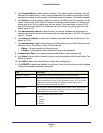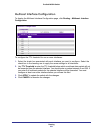
Routing
286
ProSafe M5300 Switch
Multicast
IP Multicasting enables a network host (or multiple hosts) to send an IP datagram to multiple
destinations simultaneously. The initiating host sends each multicast datagram only once to a
destination multicast group address, and multicast routers forward the datagram only to hosts
who are members of the multicast group. Multicast enables efficient use of network
bandwidth because each multicast datagram needs to be transmitted only once on each
network link, regardless of the number of destination hosts. Multicasting contrasts with IP
unicasting, which sends a separate datagram to each recipient host. The IP routing protocols
can route multicast traffic, but the IP multicast protocols handle the multicast traffic more
efficiently with better use of network bandwidth.
You use the IPv4/IPv6 multicast feature on the ProSafe managed switch to route multicast
traffic between VLANs on the switch. If all hosts connected to the switch are on the same
subnet, there is no need to configure the IP/IPv6 multicast feature. If the switch does not
handle L3 routing, you can use IGMP snooping or MLD snooping to manage port-based
multicast group membership. For more information, see
IGMP Snooping on page 158. If the
local network does not have a multicast router, you can configure the switch to act as the
IGMP querier. For more information, see
IGMP Snooping Querier on page 163.
If the switch is configured as a layer-3 switch and handles inter-VLAN routing through static
routes, OSPF, or RIP, and multicast traffic is transmitted within the network, enabling and
configuring layer-3 multicast routing on the switch is recommended.
From the Multicast link, you can access the following pages:
• Mroute Table on page 287
• Multicast Global Configuration on page 288
• Multicast Interface Configuration on page 289
• DVMRP on page 290
• IGMP on page 296
• PIM on page 304
• Static Routes Configuration on page 311
• Admin Boundary Configuration on page 312


















